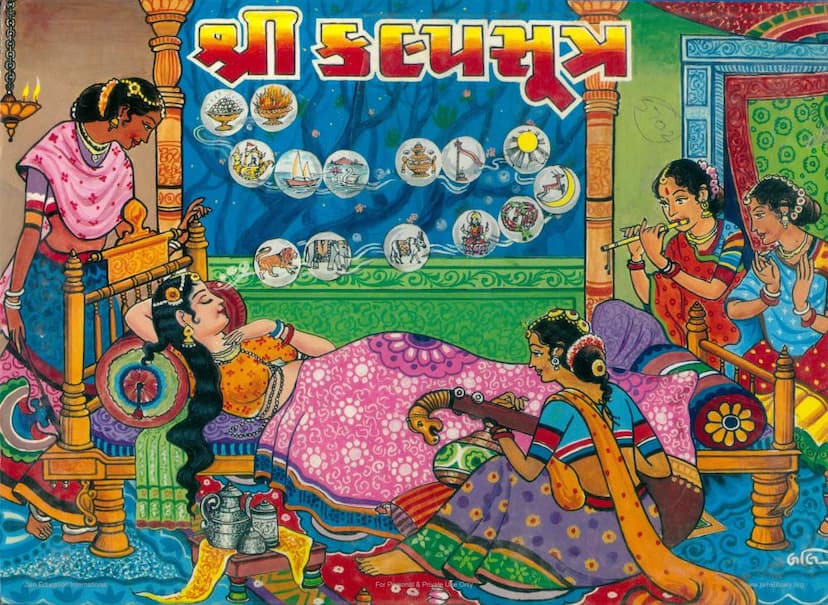Kalpsutra
Added to library: September 2, 2025

Summary
Based on the provided text snippets, here's a comprehensive summary of the Kalpasutra, focusing on the content visible in the pages:
The text appears to be a Gujarati translation and commentary on the Kalpasutra, a significant Jain scripture. The publication is by Mulund Swe Mu Pu Jain Sangh, Mumbai, with authors Gunsagarsuri and Kalaprabhsagarsuri. The catalog link suggests it's part of a larger Jain library collection.
Key Themes and Content Revealed:
- Reverence for Gurus and Spiritual Lineage: A significant portion of the provided pages (pages 4-13, 18, 24-25, 34-49) is dedicated to honoring and introducing prominent Jain acharyas (spiritual leaders) and sadhvis (female ascetics) of the Achalgacch tradition. This includes founders, influential figures, and the authors themselves. This highlights the importance of the guru-shishya parampara in Jainism.
- Deities and Guardians: Pages 14 and 15 mention and depict important Jain deities and guardian spirits like Chakreshwari Mataji, Padmavati Mataji, Mahakali Mataji, and Saraswati Mataji. This points to the devotional aspect within Jain practices.
- The Kalpasutra Itself:
- Core Subject: Page 18 explicitly states "Shri Kalpasutra Vivaran" (Commentary on the Kalpasutra) and mentions Gujarati translation, "Mandani" (introduction/preface), and ten lectures/commentaries.
- Content: Page 50 describes the Kalpasutra as a "Mokshadayak Param Pavitra Aachar" (liberation-giving, supreme holy conduct) that expounds on the high conduct of ascetics, the lives of Tirthankaras and great gurus, and the conduct of monks and nuns (Sadhvi Samachari).
- Meaning of "Kalpa": Page 50 explains that "Kalpa" in the title refers to "Achar" (conduct) or "Mandani" (introduction/preface), specifically detailing ten types of conduct.
- Ten Types of Kalpa: The text begins to explain these ten types of conduct starting from page 50:
- Achelakya Kalpa (Acelakya Kalpa): Related to wearing minimal or no clothing (ascetic practice).
- Auddeshika Kalpa: Pertaining to food or alms received.
- Shayyatara Kalpa: Regarding lodging or the place where ascetics stay.
- Rajpind Kalpa: Dealing with alms received from royalty or kings.
- Krutikarma Kalpa: Related to the act of bowing or showing reverence.
- Vrata Kalpa: Pertaining to vows, specifically mentioning the five Mahavratas.
- Jyeshtha Kalpa: Likely related to seniority or precedence among ascetics.
- Pratikraman Kalpa: Regarding the ritual of Pratikraman (confession/repentance).
- Mas Kalpa: Possibly related to rules about staying in a place for a month (Chavmas).
- Paryushan Kalpa: Referring to the rules and observances during the Paryushan festival.
- Tirthankara Conduct: The text touches upon the differences in conduct between the first and last Tirthankaras (Rishabhdev and Mahavir) and the middle twenty-two Tirthankaras (pages 51, 55, 56, 58).
- Maha-Paryushan: Pages 22, 23, 26, 56, 57 extensively discuss the significance of the Paryushan festival and its connection to the Kalpasutra, emphasizing the importance of listening to and observing its teachings during this period.
- Devadravya and Supan: Page 19 discusses the definition of "Devadravya" (deity's wealth) and its usage for renovating and constructing Jain temples, and the practice of "Uchhamani" (auctions) for its augmentation.
- Specific Teachings and Narratives:
- Rules for Laypeople Reading Kalpasutra: Page 22 provides detailed instructions for householders on how they can read the Kalpasutra, including prerequisites like abstinence from certain foods, fasting, observing celibacy, and performing specific rituals.
- Story of Nagketa: Pages 26-28, 69-73 narrate a lengthy story of Nagketa, a virtuous soul who attained Kevaljnana due to his devotion and adherence to vows, highlighting the benefits of righteous actions and the importance of the Kalpasutra.
- Details of Tirthankara Lives: Pages 50-59 and subsequent pages delve into the conduct (Kalpa) and offer explanations related to the lives of Tirthankaras, their birth, their characteristics (like the 32 types of auspicious marks), and the astronomical timing of their events. Pages 81-89 provide detailed descriptions of the characteristics of Tirthankaras. Pages 281-298 are dedicated to the detailed life stories and conduct of various Tirthankaras, starting from Rishabhdev and moving through the sequence, mentioning their previous births, lifespan, ascetics, ascetics, ascetics, and the characteristics of their teachings.
- The "Kachh-Halar Deshodharak": Page 6 highlights the role of specific Acharyas in the upliftment of the Kachh-Halar region.
- Acharya Gun sagarsuri's Contribution: Pages 10, 18, 20, 24, 25, 26, 27, 28, 32, 33, 36-41 describe the significant contributions of Acharya Gun sagarsuri, including authoring the commentary, his prolific literary works, his role in establishing educational institutions, and his impact on the Achalgacch.
- Acharya Kalaprabh sagarsuri's Role: Pages 12, 18, 20, 25, 46 describe his role as an editor and researcher for the text.
- Sadhvi Harkhshriji's Inspiration: Pages 10, 18, 20, 28, 48 highlight her role as the inspiration and driving force behind the publication of this Kalpasutra commentary.
- Structure and Format: The text includes "Mandani" (introduction), "Prakashkiya Nivedan" (publisher's note), "Prasangik Vaktavya" (occasional discourse), and "Jeevan Zaramar" (brief life sketches). It also includes verses in Sanskrit (Pattavali Prashasti on page 34-36). The commentary seems to be divided into multiple lectures or "Vyakhyan."
- Internal Usage Clause: Repeatedly, the pages state "Jain Education International For Private and Personal Use Only." This indicates the material is for educational and personal study within the Jain community.
- Restrictions on Distribution: Page 19 mentions that the book is published from a "Gyan Khata" (knowledge fund) and cannot be owned by householders. It can only be gifted to Sangh (communities) on their letterhead.
Overall Impression:
This publication of the Kalpasutra appears to be a devotional and educational effort by the Mulund Shwetambar Murtipujak Jain Sangh, focusing on the teachings of the Achalgacch tradition. It emphasizes the lives and contributions of their spiritual leaders, the importance of the Kalpasutra text, and the devotional practices associated with Jainism. The detailed biographical sketches of the Acharyas and Sadhvi indicate a strong focus on honoring the spiritual lineage. The inclusion of Tirthankara lives and the detailed explanation of the Kalpa concepts suggest a comprehensive study of Jain ascetic conduct.